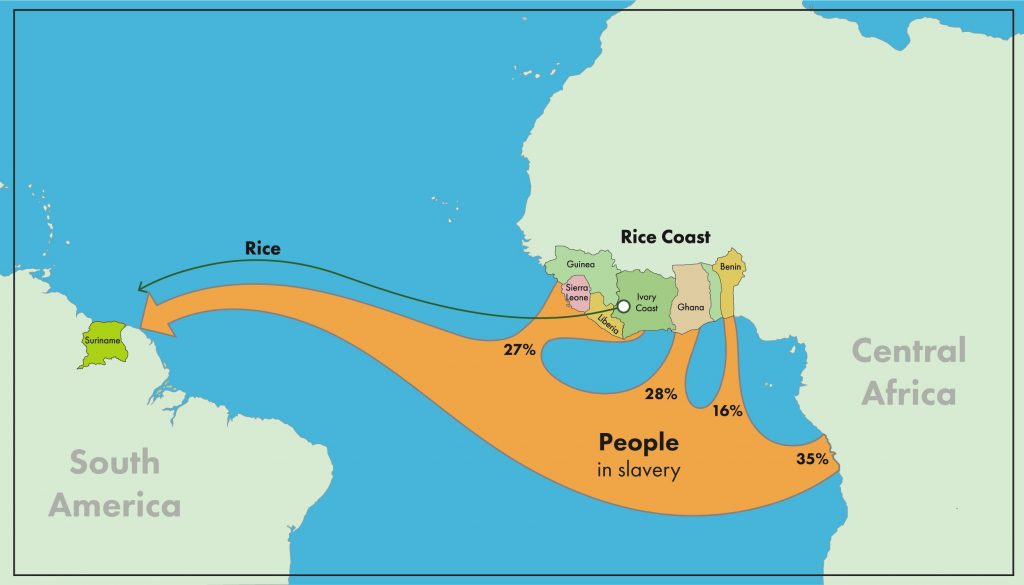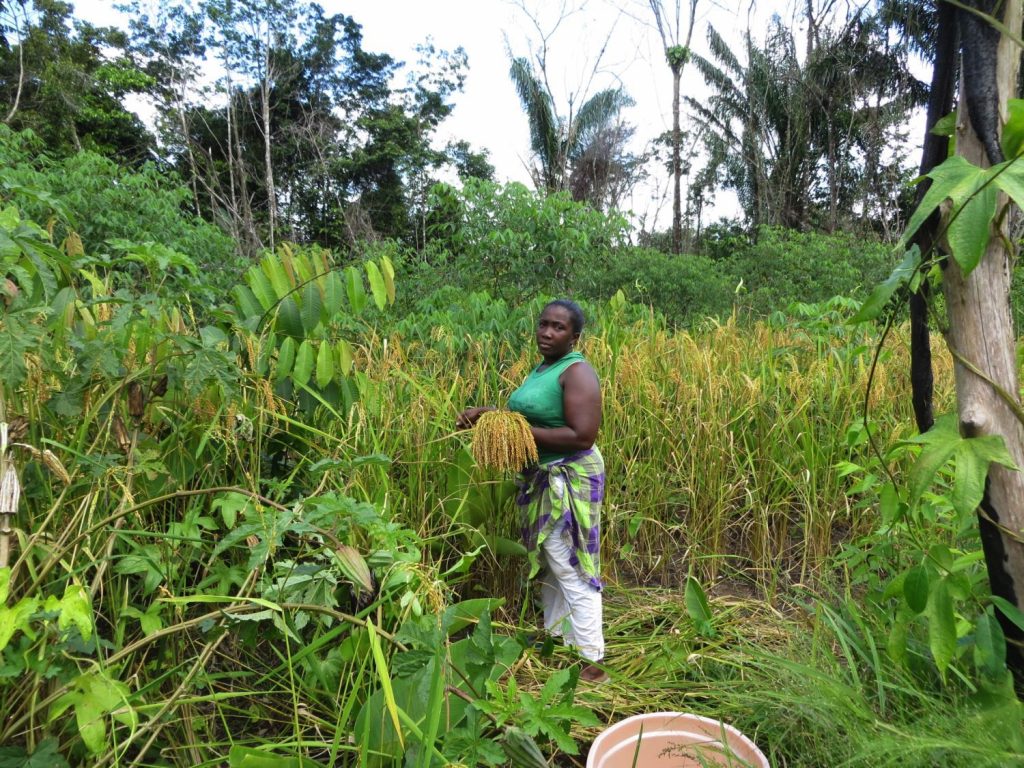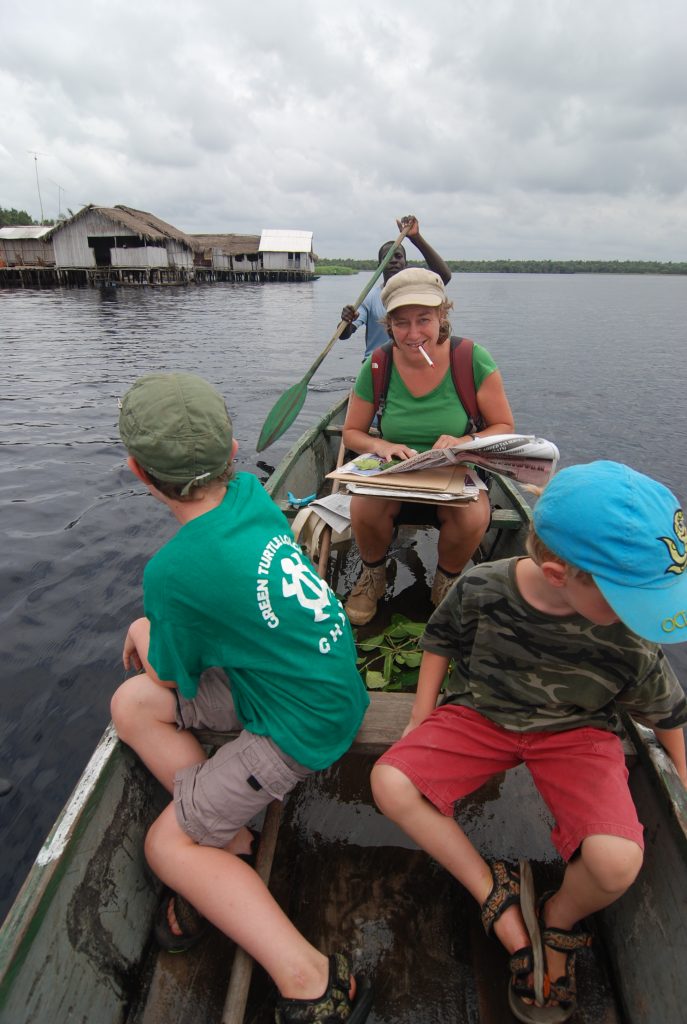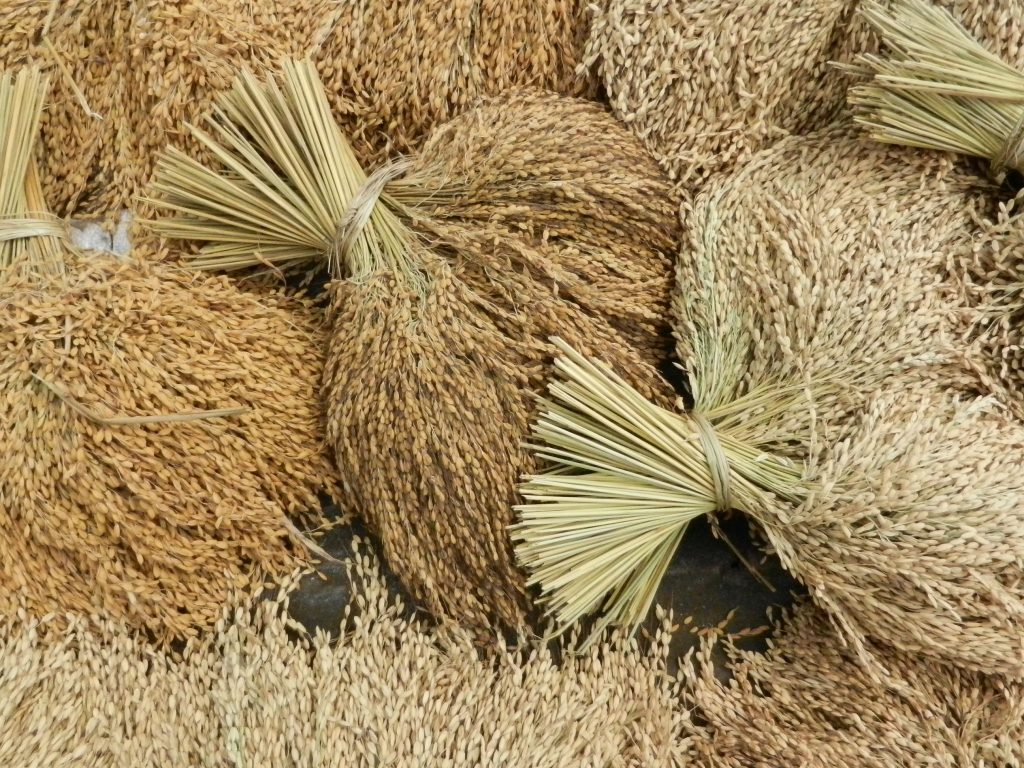Rice Reveals Enslaved Africans’ Agricultural Heritage

When Tinde van Andel purchased a small bag of unmilled rice from a market in Paramaribo, Suriname, she had no idea it would offer a novel peek into slavery’s past. The Dutch ethnobotanist, currently based at the Naturalis Biodiversity Center in Leiden, Netherlands, was in Suriname in 2006 to inventory medicinal and ritual plants for her postdoctoral research. She found a capital city market buzzing with hundreds of Maroon women selling herbal medicines and ritual plants, including rice.
Surinamese Maroons are the descendants of enslaved individuals who escaped and who were able to maintain their independence by taking refuge in the country’s interior rainforests. Despite their early struggle to subsist in a foreign landscape, the Maroons survived and even managed to keep their culture alive. Today there are more than 200,000 Maroons, the majority of whom live in Suriname and French Guiana, with a small population also in the Netherlands.
Historians estimate that more than 12 million Africans were forced to migrate to the Americas during the 350-year history of the trans-Atlantic slave trade; of the estimated 10.7 million who survived the journey, roughly 300,000 enslaved people were transported to the then Dutch colony of Suriname in northeast South America between 1668 and 1823. There, they were forced to work on booming coffee and sugar plantations.
While in Suriname, van Andel was unaware that a controversial theory—involving rice—was being debated among academics who study the history of enslavement: Had enslaved Africans brought over rice and farming know-how that helped fuel profitable rice plantations in North America? Much of the existing dogma suggested that enslaved people were nothing more than unknowing laborers performing their masters’ tasks.
The debate was stoked by the 2002 book Black Rice by Judith Carney, a rice historian and geography professor at the University of California, Los Angeles, which laid out the case that it was enslaved Africans who were responsible for South Carolina’s thriving rice economy. Rice was one of the most lucrative crops in the region during the early Colonial America days, yielding up to 25 percent profits. African rice is dark husked, and it served as a hardy grain that was used to feed ships full of enslaved people during the three-month journey across the Atlantic. A higher-yielding Asian rice would eventually dominate plantations, but African rice was reliably grown even in the unlikeliest of conditions. And Africans possessed the necessary cultivation skills to get it firmly established in the New World.
Having spent time in western Africa documenting traditional rice cultivation methods that women had used for eons, Carney realized she had an objective way to analyze rice cultivation processes in the New World. By comparing the planting, milling, and cooking methods of enslaved peoples in the Americas with those of women in Africa, as well as the microenvironments in which rice was cultivated, she painstakingly pieced together intriguing similarities between the New and Old World without relying solely on scarce, biased historical records from enslavers. “Up until the American revolution, slaves used mortars and pestles—just as in Africa in rural areas—to take off the husks of the rice,” she notes. Legends passed down over generations recount how women hid rice grains, which could serve as seeds if they were still husked, in their hair before boarding the ships. Her research bolstered the concept of “African agency”—the notion that the enslaved people had at least some command of their actions.
Carney’s investigations built on the work of slave historian Peter Wood, from Duke University, who first posited that enslaved people deserved more credit for agrarian success in the Americas. “In 1974, that was a radical concept, and he took a lot of heat for decades for voicing it,” says Carney.
Carney, too, got singed for her efforts by academic critics. “There was no smoking gun,” she says. “No slave owner was going to admit that their slaves taught them how to grow rice,” she adds.
Then word got out about van Andel’s work.
After giving a lecture about her 2006 trip to Suriname, van Andel was asked by a graduate student in the audience who had read Black Rice if she had collected rice while in the country. It took her a while to recall that she did, in fact, have a bag of ritual rice somewhere. “Do you know what you have here?” he later exclaimed when the sample was determined to be African rice. If not a smoking gun, it was, at least, a traceable bullet.
Scholars, including van Andel, widely believed that Asian rice, the white rice that’s familiar to North Americans, was the only one growing on the American plantations. Van Andel had the African rice grain, but she needed to document that the plant itself was grown in Suriname and that the rice was not imported. By this time, however, she had finished her fieldwork on medicinal plants in Suriname.
As luck would have it, in 2008 she had a short trip planned to attend a conference in Paramaribo. With only one day to find a specimen, she reached out to a friend, Berto Poeketie, from Mundje Kreek, the village where she conducted the medicinal plant inventory. He connected her with a woman, Emelina Koese, known by locals to cultivate black rice. Koese was suspicious of outsiders—as are many villagers who practice traditional religions, such as Winti, the most predominant in the region—and therefore was hesitant to share her knowledge with a stranger, says van Andel, who worked to gain Koese’s trust while on a long walk in the forest.
On that walk to the field, “there were creepy-looking bundles of herbs, bones, and fabrics that serve as anti-burglary warnings hanging from the trees,” van Andel says. And the group’s encounter with a highly poisonous fer-de-lance snake outside the rice field was interpreted by Koese as a sign that white people shouldn’t enter. In the end, van Andel assured the woman that she wanted only one plant and a picture—and that she would pay.
Read more from the archives: “The Resistance and Ingenuity of the Cooks Who Lived in Slavery.”
“It was outside the same village where I thought I had uprooted every important ritual plant,” van Andel recalls. But nobody had offered up information about the rice’s use. She learned that small amounts of African rice were used in offerings to ancestors. “That’s often how it works with ‘magic’ plants; it’s only if you ask specifically about one, then people are willing to share their knowledge,” she explains. “They want to see you know something too; then they decide it’s worthwhile talking to you.”
When van Andel confirmed the current cultivation of African rice plants in Suriname, it supported Carney’s theory that African rice arrived in the Americas via the slave trade and that the associated rice cultivation techniques were very likely introduced by Africans, says Robert Voeks, editor of the journal Economic Botany, which published the discovery in 2010.
That finding was just the beginning, however. Eager to explore how the rice got to Suriname, van Andel turned to linguistics and rice genetics—and cracked open a whole new window onto the movement of enslaved people from Africa to the Americas.
One question van Andel couldn’t shake from her time in Suriname was: Why did the Maroons use plants in radically different ways compared to nearby Indigenous people? She speculated that the different names, applications, and preparations could only be explained by a likely mixed, African heritage. Between 2010 and 2012, she traveled to Ghana, Benin, and Gabon to answer one overarching question: What happened to botanical insights during the 350-year forced migration of millions of enslaved people? What did they forget, what did they remember, and what adaptations were necessary?
While traveling in western African countries, van Andel routinely heard Surinamese names for plants. “Hundreds of names in Suriname have an African basis,” she says. In total, she compared 2,350 Surinamese plant names with western African ones. Among Maroons, more than 40 percent of the vernaculars strongly resembled African plant names in sound, structure, and meaning. Van Andel saw the flora “through African eyes,” she says. Using the scientific literature, she also compared plant names from other countries. The most striking correspondence was found among plant names from Gabon and Angola, among the primary areas where the Dutch purchased enslaved people. Her paper, published in the Proceedings of the National Academy of Sciences in 2014, offered proof that enslaved Africans recognized a significant portion of American flora.
The “old-fashioned idea,” says van Andel, is that “slaves came to [the] New World and had no history; they were like blank slates. It is so not true.” If you can’t bring anything but your memory, she adds, that becomes your identity. Tropical Africa and the Americas are pretty different, but there is quite a bit of overlap in plant families. “It’s the African knowledge of rainforest species that helped Maroons survive,” says van Andel. Voeks agrees. “African slaves brought their own traditions and superimposed them onto species or genera that resembled those left behind,” he says. ‘They were significant agents of ecological change.”
Van Andel knew she could trace the Maroon rice to its African origin—if only she could get at the genes. In 2015, while at a conference in Western Cape, South Africa, van Andel met up with New York University postdoc Rachel Meyer and hatched a collaboration to sequence rice genomes of Maroon and African traditional varieties in search of a match. In October 2016, the team, including Carney, published findings in Nature Plants suggesting the likely origin of Maroon rice was in the Guinea Highland countries, notably the western Ivory Coast. The Dutch took the vast majority of their enslaved people from Ghana, Benin, and Central Africa. And slave ship records show that food provisions were obtained while sailing along the West African coast.
“Our study demonstrates the capacity to use plant sequence information to gain insights into population movements,” she says.
The finding about the origins of Maroon rice is an intriguing example of a budding new field—using plants to shed light on history. It’s the first time genetics has been used to pinpoint the origin of a crop grown by enslaved people in the Americas, but not the first time plants have been used as proxies for human migrations, says Terry Brown, a biomolecular archaeologist at Manchester University in the U.K.
Using plant genetics to trace human migrations makes sense for a couple of reasons: plant reproduction is often less convoluted than human affairs, and signs of cultivation provide evidence of the plant’s value to humans. “Humans have the ‘Saturday night effect’—males can go a short distance and spread their genes without migration,” he adds. Plants, however, are stuck in the ground and offer an indication of how plant-based economies spread.
In addition to uncovering the link between New World rice cultivated by enslaved people and its origins in Africa, new genetic techniques have overturned the notion that the origin of agriculture in the Fertile Crescent was a sudden invention. “We now believe it was a protracted process, taking 8,000 to 9,000 years for agriculture to get established as early hunter-gathers began manipulating to make wild plants more productive,” says Brown. He and others have used the genomes of domesticated barley and wheat to show that they couldn’t have come from a single source population but were hybridized from different parts of the region.
For van Andel, there’s more to the slavery story yet to discover. She hopes to expand her efforts and look at other crops, from okra to yams to bananas. “The [Surinamese Maroons] really know about their ancestors,” she says. “It’s time we should ask them more.” And in return, she hopes to help the Maroons safeguard some of their cultural heritage.
To that end, van Andel recently received funding from National Geographic’s Science and Exploration program in Europe to explore Maroon communities in French Guiana, Suriname’s eastern neighbor, along with Marie Fleury, an ethnobotanist at France’s National Museum of Natural History. The team plans to begin fieldwork there this summer when rice is ripe.
Maroon culture wasn’t unfamiliar to van Andel when she began her research; small pockets of Surinamese Maroons live near her in the Netherlands. In fact, there is an active trade between the two countries of sacred plants used in rituals. It’s remarkable those customs have survived, she says, since Winti, for example, was forbidden until 1971.
“The Maroons in Suriname have been discriminated against, sometimes looked at as backward people who live in the forest,” says van Andel. If her efforts make one thing clear, it’s that Maroons should take pride in having kept their extraordinary knowledge of plants intact over the generations. In addition, she says, these overlooked crop varieties merit conservation efforts. For Maroons, rice cultivation kept not only their traditional religion alive but their history too, she says, which is especially significant “in slave country where people were not supposed to have a history.”
Correction: September 9, 2021
To recognize the humanity of those who were enslaved, this article has been edited to change “slave” to “enslaved people,” except for direct quotes.





































